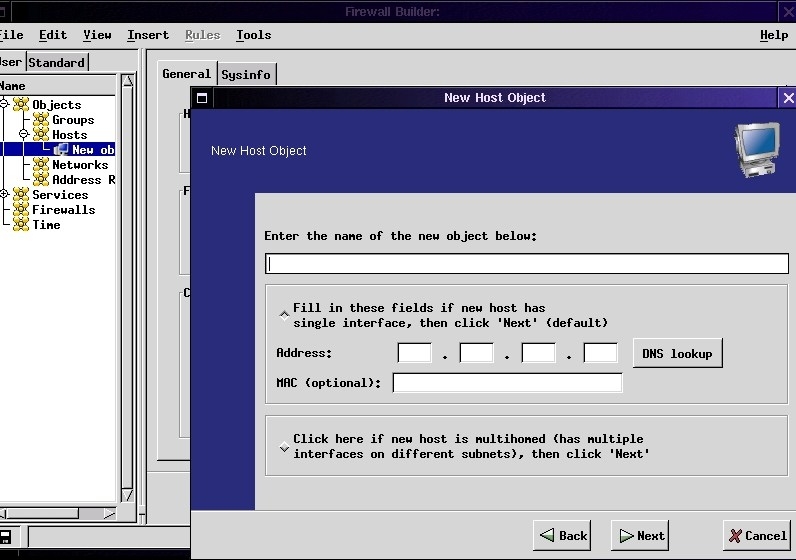

- Firewall builder for linux how to#
- Firewall builder for linux install#
- Firewall builder for linux Patch#
- Firewall builder for linux password#
- Firewall builder for linux download#
If that happens, follow some descriptions how to recover from a bad firmware flash. OTHERWISE YOU ARE OUTSIDE OF YOUR WALL (THAT'S REALLY SECURE, ISN'T IT?). NEVER FORGET TO ALLOW SSH ACCESS IN A RULE TO YOUR FIREWALL. The basic ruleset is not secure because it allows any connection to extern. There are some points, you should take care of: If you confirm this page, you'll see a dialogue about installing the firewall.
Firewall builder for linux password#
The username is "root" and you need to enter your password here.

Firewall Builder needs the connection details now. The next step is compiling your firewall rules. This will prompt you, where to save the fwbuilder file on your computer for later configuration.

Press the icon with the computer and the two arrows.
Firewall builder for linux install#
Now you are ready to install your first iptables firewall with Firewall Builder.
Firewall builder for linux download#
You can download them free of charge on the net. On Windows I use pscp.exe and plink.exe as recommended. Just go to edit->configuration and choose the tab "SSH". The next step is to tell Firewall Builder where to find the ssh tools.(Just do a right click on the 0 and choose "delete rule".) In my opinion, the first one can't work (or better - this rule will break your DHCP for the first configuration.) So delete rule number 0. In the big field you see the rules of your firewall. Firewall Builder will prompt you, that it can do some changes for you automatically. Double Click this interface and change the name from "vlan1" to "ppp0". There should be one interface, called "outside (dyn ext)". (If you need to use PPPoE to connect to the internet) Now you see your firewall object on the left side under the folder firewalls.First change the version in the Firewall box (the version field is directly under the platform field) to "1.2.9 or later" and commit your changes. Now you'll be presented with your firewall.Now you are presented with the different templates.Check the box to use a preconfigured firewall. The firewall-software in your case is "iptables" and the operating system is "Linksys/Sveasoft". Now you are prompted for the name (Give it some like DD-WRT for example). That's done by right click to firewalls -> create new firewall. After starting the fwbuilder software, first you need to create the firewall object.Choose "Compile" and "Install".Ĭhoose a directory to save the compiled policy file (in this case /etc/fwbuilder). When you have finished creating your policy, install it. If you want to use your box as a router to connect your private network to the Internet, a masquerade rule is useful. You may want to have a "allow all" ruleset for testing purposes or similar use. You can use the context menu to create additional rules or the rules menu on the top. Now you can create your rules by dragging and dropping objects from the left side. If you change to the "Standard" library you will find a almost complete set of object predefinitions. You can also define a interface to have a dynamic IP address. You can do this automatically provided you have snmp installed, active and configured. There is no firewall defined at this point.Įnter a name for your firewall and choose "iptables" and "Linux 2.4/2.6"ĭefine your interfaces. It is in your obligation to do so, the fwbuilder executable lies in /usr/bin. NB: My package does not create a Fwbuilder menu link. You need the packages "fwbuilder" and "libfwbuilder". The better and easier way would be to grab the Slackware packages from here. If you want to start from scratch, grab the sources and compile them. The folks at Fwbuilder (provide by default no Slackware package. Firewall Builder currently supports iptables, ipfilter, OpenBSD PF as well as Cisco PIX and Cisco IOS extended access lists. Firewall Builder uses object-oriented approach, it helps administrator maintain a database of network objects and allows policy editing using simple drag-and-drop operations. It consists of a GUI and set of policy compilers for various firewall platforms. I used to work with Checkpoint firewall - this may be the reason why I like the drag and drop Fwbuilder approach.įrom the website: Firewall Builder is multi-platform firewall configuration and management tool. There are some tools one can use to configure the netfilter firewall, like KMyFirewall, Guarddog, Shorewall, Webmin and. The only question is, which tool to use to configure it. Filter according to user authentication.Furthermore, it has a bunch of advanced features, like:
Firewall builder for linux Patch#
With a patch it can even work at layer seven as application firewall. Netfilter / iptables is by default a layer four stateful firewall.


 0 kommentar(er)
0 kommentar(er)
